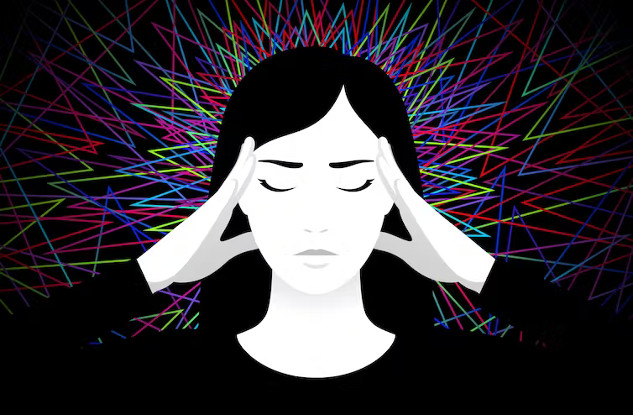
Elena Abrazhevich/Shutterstock
At the age of 12, “out of nowhere”, Matt says he started having repetitive thoughts concerning whether he wanted to end his life. Every time he saw a knife, he would ask himself: “Am I going to stab myself?” Or, when he was near a ledge: “Am I going to jump?”
Matt had heard a lot about teenage depression, and thought this must be what was going on. But it was confusing, he says: “I didn’t feel suicidal, I really enjoyed my life. I just had an intense fear of doing something to hurt myself.”
Shortly afterwards, pre-empted by hearing about a notorious banned film, Matt began questioning whether he, like the central character, might be a serial killer. These thoughts “kept coming and coming” and he would lie in bed running over scenarios, trying to work out whether he was “going crazy”:
I really needed help. I didn’t know who to talk to. But it wasn’t on my radar to think about this as OCD.
Obsessive-compulsive disorder (OCD) is a significant mental health diagnosis in the 21st century. The World Health Organization (WHO) lists it as one of the ten most disabling illnesses in terms of loss of earning and reduced quality of life, and OCD is frequently cited as the fourth most common mental disorder globally after depression, substance abuse and social phobia (anxiety about social interactions).
Yet everything Matt knew about OCD, he tells me, came from daytime talkshows where “people were washing their hands 1,000 times a day – it was all about external and really extreme behaviours”. And that didn’t feel like what he was going through.
A similar experience is recounted in the 2011 book Taking Control of OCD by John (not his real name) who, after a colleague had taken their own life, became “inundated with thoughts” about what he might do to himself. Every time he crossed the road, John thought: “What would happen if I stopped moving and was run over by a bus?” He also had thoughts of murdering those he loved. John recalled:
Try as I might, I just couldn’t chase the thoughts out of my head … When I tried to explain what was going on to my girlfriend, I couldn’t find a way of articulating what was happening to me … At the time, I thought OCD was all about triple-checking you had locked the front door and that your drawers were tidy.
Despite the prevalence of OCD in contemporary society, the experiences of Matt and John reflect two important features of this disorder. First, that the stereotype of OCD is one of washing and checking behaviours – the compulsions aspect, defined clinically as “repetitive behaviours that a person feels driven to perform”. And that obsessions – defined as “unwanted, unpleasant thoughts” often of a harmful, sexual or blasphemous nature – are viewed as obscure, confusing and unrecognisable as OCD.
People who experience obsessional thoughts are therefore frequently unable to identify their symptoms as OCD – and neither, very often, are the experts they see in clinical settings. Due to mischaracterisations of the disorder, OCD sufferers with non-typical, less visible presentations usually go undiagnosed for ten or more years.
When John visited his GP, he was diagnosed with depression. He recalled that the GP concentrated more on the visible effects of his distress - a lack of appetite and disrupted sleeping patterns. The thoughts remained invisible. As he put it:
I don’t know how you’re supposed to tell someone you don’t know that you have thoughts about killing people you love.
Even for those with “textbook” OCD such as my friend Abby, “the compulsion is just the tip of the iceberg”. Abby was able to self-diagnose at the age of 12, when she experienced handwashing and locking door compulsions. She says people still think of her as “Abby [who] likes to wash her hands a lot”.
Now, she tells me, “I realise that I have no interest in washing my hands – I’m a pretty messy person, and I don’t mind other people being messy.” Rather than a love of cleaning, her acts were related to the altogether scarier obsessional thought: “What if I am going to hurt other people?”
Clinical guidelines, such as those provided in the UK by the National Institute for Health and Care Excellence, define OCD as being characterised by both compulsions and obsessions. So, why do the difficulties encountered by Matt, John and Abby – of recognising the internal thoughts that dominate their lives – appear to be so common?
My experience of OCD
From the age of 16, I have also suffered with thoughts that I later came to associate with OCD, but which began as invisible and tormenting. An article I wrote in 2014, entitled The Unseen Obsession, described my experience of having left university midway through my studies due to a single thought that gathered “such power that I even ended up attacking my body in an attempt to eliminate its force”. I wrote:
I have suffered with obsessional thoughts for the last four years, and can safely say that [OCD] is far from being about clean hands.
My obsessions have taken many forms since my teenage years. They began with me wondering whether things really existed, whether my parents were really who they said they were, and whether I wanted to harm – and was a risk to – my family, friends, even my dog.
Many of us know what it is like to ruminate about a person, a conflict, or something else we feel anxious about. But for those with obsessional thoughts (diagnosed or otherwise), this is quite different to simply “overthinking”. As I attempted to explain in my article:
Conversations falter as the thought leaps through your mind. Other topics seem less important, and time to yourself provides space to assess, analyse, and look for evidence of the thought being ‘true’ … [Obsessing] is like fighting: you push and shove your thoughts away and they come back with twice as much force. You spend time trying to avoid them and they pop up everywhere, taunting and mocking your failed attempt at running away.
It took me six months of weekly therapy sessions before I felt able to voice my obsessional thought to my therapist – someone I had known for a number of years. My unwillingness to be open about it was not only tied up with feelings of shame about its taboo content, but also my inability to see such thinking as part of a recognised disorder.
The question of what constitutes OCD, why we understand – and misunderstand – it as we do, as well as my own experience of living with it, led me to study how OCD became recognised and categorised as a mental health disorder.
In particular, my research shows that there are important insights to be gained from the research decisions made by a group of influential clinical psychologists in south London in the early 1970s – shedding light on why so many people, myself included, still struggle to recognise and make sense of our obsessional thoughts.
The origin of the concepts
Categories of mental illness are not stable across time. As medical, scientific, and public knowledge about an illness changes, so does how it is experienced and diagnosed.
Prior to the 1970s, “obsessions” and “compulsions” did not exist in a unified category – rather, they appeared in an array of psychiatric classifications. At the start of the 20th century, for example, British doctor James Shaw defined verbal obsessions as “a mode of cerebral activity in which a thought – mostly obscene or blasphemous – forces itself into consciousness”.
Such cerebral activity could, according to Shaw, arise in hysteria, neurasthenia, or as a precursor to delusions. One of his patients – a woman who experienced “irresistible, obscene, blasphemous and unutterable thoughts” – was diagnosed with obsessional melancholia, a “form of insanity”.
The symptom arose from what Shaw defined as “nervous weakness”, an explanation that reflected the broader 19th-century view that obsessional thoughts were indicative of a fragile nervous system – either inherited, or weakened through overwork, alcohol or promiscuous behaviour (described as “degeneration theory”). Notably, Shaw did not mention any form of repetitive behaviour in relation to these verbal obsessions.
At a similar time to Shaw’s writings, Sigmund Freud, the Austrian founder of psychoanalysis, developed his psychoanalytic category of “Zwangsneurose – translated in Britain as "obsessional neurosis” and in the US as “compulsion neurosis”. In Freud’s writings, the “Zwang” referred to persistent ideas that emerged from a repressed conflict between unresolved childhood impulses (those of love and hate) and the critical self (ego).
Freud’s most famous case study, published in 1909, featured the “Rat Man”, a former Austrian army officer who possessed a variety of elaborate symptoms. In the first instance, he had become obsessed that he would fall victim to a horrific rat-based punishment that had been recounted to him by a colleague. The patient also expressed that if he had certain desires such as a wish to see a woman naked, his already-deceased father “will be bound to die”.
The Rat Man was described by Freud as engaging in a “system of ceremonial defences” and “elaborate manoeuvres full of contradictions” that have been read by some as the behavioural aspects of what would become OCD. However, there are crucial differences between the “defences” of Freud’s client and the compulsions of OCD, including that the former largely involved thinking rather than acting, and were by no means consistent or stereotyped.
The psychoanalytic category of “obsessional neurosis” was adopted and modified in Britain during the first world war, and became a staple – but inconsistently defined – diagnosis in British psychiatric textbooks of the inter-war period. Up to the 1950s, the terms “obsession” and “compulsion” were being used interchangeably in psychiatric writing. The complexity surrounding their meaning is demonstrated in the writings of Aubrey Lewis, a leading figure in post-war British psychiatry, who referred to “obsessional illnesses” as being made up of “compulsive thoughts” and “compulsive inner speech”.
Like Freud, Lewis mentioned the “complex rituals” of the obsessional – such as the patient “who is perpetually putting himself in the greatest trouble to ensure that he never steps on a worm inadvertently”. But he cautioned against “the dangers of associating any kind of repetitious activity with obsessionality”, writing that “it certainly cannot be judged on behaviourist grounds”.
Defining OCD by visible behaviour
OCD began to emerge in the form we recognise it today from the early 1970s – and was established as a formal psychiatric disorder through its inclusion in the third and fourth editions of the American Psychiatric Association’s Diagnostic and Statistical Manual (commonly known as DSM-III and DSM-IV) in 1980 and 1994.
The centrality of visible and measurable behaviours in the categorisation of OCD – particularly washing and checking – can be traced back to a series of experiments conducted by clinical psychologists in the early 1970s at the Institute of Psychiatry and the Maudsley Hospital in south London.
Under the direction of South African psychologist Stanley Rachman, the complex array of symptoms contained in the categories of obsessional illness and obsessional neurosis were divided into two: “visible” compulsive rituals, and “invisible” obsessional ruminations. While Rachman and his colleagues conducted a large research programme on compulsive behaviours, obsessions were relegated to the backburner.
For example, in their investigation of ten psychiatric inpatients diagnosed with obsessional neurosis, “compulsions had to be present for entry into the trial and patients complaining of ruminations were excluded” – a statement reiterated throughout subsequent experiments.
Indeed, this study did not merely require patients to exhibit some form of visible compulsion. The ten patients included were exclusively those with “visible handwashing” behaviour, which was viewed as the “easiest” symptom to experiment on. Likewise, the second round of studies only included patients who engaged in visible “checking” behaviour, such as whether a door was unlocked.
In a 1971 paper, Rachman offered his rationale for taking this approach, explaining how “obsessional ruminators raise special problems for the clinical psychologist because of their subjective, private nature”. This, he argued, was in contrast with “the other main feature of obsessional neurosis, compulsive behaviour, which can be approached with greater ease. It is visible, has a predictable quality, and many reproducible analogies in animal research”.
Rachman viewed compulsions as “visible” and “predictable” in large part due to the way clinical psychology had developed as a new profession in Britain, at the Maudsley Hospital in particular, in the decades following the second world war. To differentiate their practice from the existing mental health professions of psychiatry (medically trained doctors specialising in mental health) and psychoanalysis (talking therapy derived from Freud), these early clinical psychologists presented themselves as “applied scientists” who brought scientific methods from the laboratory to a clinical setting. Their conception of science was rooted in empiricism – with an emphasis on visibility, measurability and experimentation.
As part of this commitment to empirical science, these clinical psychologists adopted a model of anxiety derived from 20th-century behaviourism. This focus on observable behaviour was viewed as having much greater scientific value than psychoanalysis, which dealt with the “unverifiable” and “unscientific” realm of thoughts and thinking.
So, when obsessional ruminations gained a renewed focus in the mid-1970s, it was through this lens of visible compulsive behaviours. Rachman and his colleagues started talking about “mental compulsions” (such as saying a good thought after a bad thought) as “equivalent to handwashing”- rather than focusing on the importance and content of these thoughts in their own right.
In the early 1980s, clinical psychology came under pressure from cognitive psychologists (those concerned with thinking and language) for its reductive focus on behaviour. But despite this move to include cognitive approaches, the centrality of visible behavioural compulsions has continued to characterise perceptions of OCD in cultural and clinical domains.
This is perhaps most evident in media portrayals of the disorder – a critique taken up by cultural scholars such as Dana Fennell, who look at representations of OCD in TV and film.
The archetypal portrayal of OCD has not been helped by the recent publicity given to David Beckham and his extensive tidying. When I ask Abby what she thought about the attention that Beckham’s OCD was receiving in the media, she replies: “It’s so boring. It’s the same presentation that always gets thought of as OCD.”
Limitations to the ‘gold standard’ treatment
This archetypal portrayal of OCD also relates to how it is treated. The “gold standard” treatment in the UK today is the behavioural technique of exposure and ritual prevention (ERP), either on its own or combined with cognitive therapy. ERP gained acceptance from the experiments of Rachman and colleagues in the early 1970s, when they were exclusively working with patients with observable behaviours.
One of their key studies involved patients from the Maudsley Hospital who repeatedly washed their hands. They were told to touch smears of dog excrement and put hamsters in their bags and in their hair, while being prevented from washing for increased lengths of time.
Such experiments were again governed by observability and measurability. The “success” of ERP treatment – and its perceived superiority over psychiatric and psychoanalytic methods – was demonstrated by a reduction in the patients’ visible handwashing behaviour.
Today, if you are diagnosed with OCD by a psychiatrist and given OCD-specialist treatment via the NHS, you will most likely be told to undergo the same kind of ERP procedure that hospital inpatients were experimentally given in the 1970s: touching a set of items that you fear (exposure) while being prevented from engaging in your usual compulsive behaviour.
An identical method is also used when it comes to obsessional thoughts. Patients are asked to identify their worrying obsession, then either expose themselves to provoking situations or repeat the thought in their mind without engaging in “mental compulsions” – such as counting, replacing a bad thought with a good thought, or trying to “solve” the content of the obsessional thought.
It’s certainly true that this form of behavioural therapy can be hugely helpful in the treatment of OCD symptoms. Abby, after undergoing ERP for 14 years, said she had “developed a lot of practices around not giving into my [washing and checking] compulsions”.
I also found the approach beneficial in reducing the threatening quality of my obsessional thoughts. Repeating “I want to hurt my family” or “I don’t really exist” to myself over and over again, without actually trying to solve these issues, reduced the time I spent ruminating.
However, while being a huge advocate of ERP, Abby also observed that “sometimes when I get rid of a compulsion, it doesn’t mean I just get rid of the obsession.” While the “outward compulsions” disappear, “it doesn’t mean my mind stops cycling and mental questioning”.
Some contemporary clinicians have referred to ERP, designed around visible symptom reduction, as a “whack-a-mole technique” – you get rid one symptom (obsession or compulsion) and another pops up.
ERP is frequently accompanied with cognitive therapy techniques, such as cognitive restructuring (identifying beliefs and providing evidence for and against them), or being told that obsessions are “just thoughts”, that they are meaningless, and that you do not want to enact them.
Despite the success of cognitive-behaviour therapy (CBT) and ERP in scientific trials, a major review of evidence in 2021 questioned whether the effects of the approach in treating OCD had been overstated – reflecting the high proportion of OCD cases that are designated as “treatment resistant”.
I also believe there are some crucial limitations to contemporary treatments for OCD. Exposure (ERP) techniques stem from a period in which thoughts were not being considered at all by clinical psychologists, while CBT designates the content of obsessional thoughts as unimportant. Matt, like me, has found that CBT “can only take you so far”, explaining:
Part of this was that [CBT therapists] are so committed to the idea that thoughts don’t have meaning … [They] treat your symptom and once those are gone, you should get on with your life. I didn’t find that there was a way of thinking about [my] ruminations in the context of my whole life.
Experiences of alternative treatments
So much of my understanding about OCD has changed since I first wrote about it for Rethink Mental Illness almost a decade ago. Thinking about the historical development and categorisation of OCD has, it turns out, given me a greater sense of ease regarding this widely misunderstood condition. I feel less bound by our current conceptual frameworks, and more able to reflect on what I think is helpful in terms of how to successfully manage my obsessional thoughts.
For example, despite being warned away from psychoanalysis from a young age (my mum is a clinical psychologist, and psychologists are often fervently anti-psychoanalytic!), I have found psychoanalysis incredibly helpful in becoming comfortable with my thoughts.
This is because CBT typically focuses on present symptoms without looking into their meaning or how they relate to your personal history, and this comes into tension with my desire, as a historian, to think about the past. In contrast, psychoanalysis locates obsessional thoughts in history – pointing to childhood as a crucial point of psychic development. I have been able to understand my obsessions as the result of a deep childhood fear concerning the death of my loved ones, from which I developed a rigid desire for control.
As a young teenager trying to determine what was going on with him, Matt went to the public library and took out a Freud reader. He describes this as “the worst possible thing for a 14-year-old to read”, as it made him believe “that I did really have all these [murderous suicidal] impulses and all my fears are true”.
Despite this experience, while training to become a social worker, he “got into psychoanalysis as an alternate way to think about therapy and think about my own experience”. For him, psychoanalysis revealed the opposite to the image of “OCD as handwashing”.
Instead, he says, it focused on the aspects of “obsessionality that are internal”, showing him that the “mind is so powerful that it can produce a lot of imaginary fears”. It also allowed him to see “OCD symptoms as wrapped up with my whole life”.
Particularly profound in psychoanalytic thought is the acceptance of the complexity and unknowability at the heart of human experience. As Jaqueline Rose, professor of humanities at Birkbeck, University of London, wrote::
Psychoanalysis begins with a mind in flight, a mind that cannot take the measure of its own pain. It begins, that is, with the recognition that the world – or what Freud sometimes refers to as ‘civilisation’ – makes demands on human subjects that are too much to bear.
This idea of “a mind in flight” has helped me think about my obsessions – whether my parents are really who they say they are; am I going to hurt those I love? – as part of a battle for certainty and control that is both unattainable and understandable, considering the world we live in.
The aim of psychoanalytic treatment is not to eradicate symptoms but to bring to light the difficult knots that humans have to deal with. Matt refers to psychoanalysis as acknowledging “a sort of messiness of the mind … I’ve found the psychoanalytic view of accepting your own messiness extremely helpful”. Rose similarly describes psychoanalysis as “the opposite of housework in how it deals with the mess we make”.
In the UK, psychoanalysis has been rejected within NHS service provision. And I believe this is, at least in part, a result of historical critiques levelled at it by clinical psychologists as they developed behaviour therapies to treat OCD in the late 20th century.
‘A lot of emotion and sadness’
While compulsive behaviour such as handwashing and checking is widely perceived as “representative” of OCD, the tormenting experience of having obsessional thoughts is still rarely acknowledged and discussed. The shame and confusion attached to such thoughts, coupled with the feeling of being misunderstood, make this an important issue to address, particularly when misdiagnosis of OCD is so high.
My PhD on the history of OCD has also showed me the ways in which psychological research shapes how we conceive of diagnostic categories – and consequently, ourselves. While psychology’s commitment to objectivity, empiricism and visibility has provided tools that are tremendously useful in the clinic, my research sheds lights on how the often-exclusive focus on visible symptoms has at times trumped the appreciation of the complex experience of having obsessional thoughts.
I first met Matt in 2019 at the first OCD in Society conference, held at Queen Mary University of London, where he was giving a presentation on the “multiple meanings of OCD”. We discussed our own experiences of the disorder, and what we thought that history, psychoanalysis and anthropology could contribute to understandings of OCD.
Matt was 34, and he told me this was the first time he “had ever voiced the internal stuff out loud, and heard other people talk about it”. Recalling how this made him feel, he continued:
I felt a lot of emotion and sadness. The isolation had been such a big part of my life that I had stopped noticing it. Then being out of the isolation was such a relief, it made me realise how bad it had been.
Eva Surawy Stepney, PhD Researcher, University of Sheffield
This article is republished from The Conversation under a Creative Commons license. Read the original article.
Books on Improving Performance from Amazon's Best Sellers list
"Peak: Secrets from the New Science of Expertise"
by Anders Ericsson and Robert Pool
In this book, the authors draw on their research in the field of expertise to provide insights into how anyone can improve their performance in any area of life. The book offers practical strategies for developing skills and achieving mastery, with a focus on deliberate practice and feedback.
Click for more info or to order
"Atomic Habits: An Easy & Proven Way to Build Good Habits & Break Bad Ones"
by James Clear
This book offers practical strategies for building good habits and breaking bad ones, with a focus on small changes that can lead to big results. The book draws on scientific research and real-world examples to provide actionable advice for anyone looking to improve their habits and achieve success.
Click for more info or to order
"Mindset: The New Psychology of Success"
by Carol S. Dweck
In this book, Carol Dweck explores the concept of mindset and how it can impact our performance and success in life. The book offers insights into the difference between a fixed mindset and a growth mindset, and provides practical strategies for developing a growth mindset and achieving greater success.
Click for more info or to order
"The Power of Habit: Why We Do What We Do in Life and Business"
by Charles Duhigg
In this book, Charles Duhigg explores the science behind habit formation and how it can be used to improve our performance in all areas of life. The book offers practical strategies for developing good habits, breaking bad ones, and creating lasting change.
Click for more info or to order
"Smarter Faster Better: The Secrets of Being Productive in Life and Business"
by Charles Duhigg
In this book, Charles Duhigg explores the science of productivity and how it can be used to improve our performance in all areas of life. The book draws on real-world examples and research to provide practical advice for achieving greater productivity and success.






















